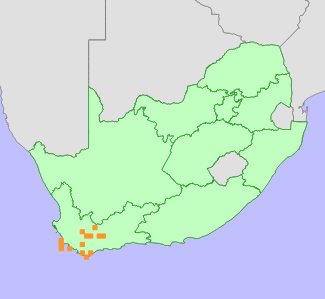|
Scientific Name | Xiphotheca fruticosa (L.) A.L.Schutte & B.-E.van Wyk |
Higher Classification | Dicotyledons |
Family | FABACEAE |
Synonyms | Crotalaria lanata Thunb., Priestleya villosa DC. |
National Status |
Status and Criteria | Least Concern |
Assessment Date | 2012/12/19 |
Assessor(s) | L. von Staden |
Justification | A widespread (EOO 20 302 km²), but rarely recorded species, currently known from 15-20 locations. Although potentially threatened on the Cape Peninsula and the Riviersonderend and Bredasdorp mountains, this species is not suspected to be declining or in danger of extinction. |
Distribution |
Endemism | South African endemic |
Provincial distribution | Western Cape |
Range | Cape Peninsula to Laingsburg and Bredasdorp. |
Habitat and Ecology |
Major system | Terrestrial |
Major habitats | Fynbos |
Description | Sandstone slopes in fynbos, 100-1200 m. |
Threats |
| This slow-growing, long-lived reseeder is potentially vulnerable to too frequent fire. Parts of the Cape Peninsula has been subjected to very frequent fires, but recent records indicate that this species survives in spite of frequent fires. Some subpopulations may have been lost to urban expansion on the Cape Peninsula in the past, but remaining subpopulations are now mostly protected within the Table Mountain National Park. This species' habitat on the Cape Peninsula was also formerly severely infested by alien invasive plants, but alien plants have been extensively cleared. Ongoing clearing efforts are however needed to prevent reinvasions. Subpopulations in the mountains between Stanford and Bredasdorp, as well as the Riviersonderend Mountains, are also potentially threatened by competition from unmanaged alien invasive plants. Elsewhere, this species occurs in rocky montane areas where there is little threat to its habitat. |
Population |
A widespread, but rarely recorded species. A number of recent records from the Cape Peninsula indicate that previous reports that this species has become rare or possibly extinct in this area (Raimondo et al. 2009) are incorrect.
|
Population trend | Stable |
Notes |
| Subpopulations on the Elim flats resprout while all other populations growing at high altitude are reseeders the Elim populations and may be a different species, but more fieldwork is required to assess this. |
Assessment History |
Taxon assessed |
Status and Criteria |
Citation/Red List version | | Xiphotheca fruticosa (L.) A.L.Schutte & B.-E.van Wyk | VU B1ab(iii,v) | 2012.1 | | Xiphotheca fruticosa (L.) A.L.Schutte & B.-E.van Wyk | VU B1ab(iii,v) | Raimondo et al. (2009) | | Xiphotheca fruticosa (L.) A.L.Schutte & B.-E.van Wyk | Not Threatened | Hilton-Taylor (1996) | |
Bibliography |
Goldblatt, P. and Manning, J.C. 2000. Cape Plants: A conspectus of the Cape Flora of South Africa. Strelitzia 9. National Botanical Institute, Cape Town.
Hilton-Taylor, C. 1996. Red data list of southern African plants. Strelitzia 4. South African National Botanical Institute, Pretoria.
Raimondo, D., von Staden, L., Foden, W., Victor, J.E., Helme, N.A., Turner, R.C., Kamundi, D.A. and Manyama, P.A. 2009. Red List of South African Plants. Strelitzia 25. South African National Biodiversity Institute, Pretoria.
Schutte, A.L. 1997. A revision of the genus Xiphotheca (Fabaceae). Annals of the Missouri Botanical Garden 84:90-102.
|
Citation |
| von Staden, L. 2012. Xiphotheca fruticosa (L.) A.L.Schutte & B.-E.van Wyk. National Assessment: Red List of South African Plants version 2024.1. Accessed on 2025/12/10 |
 Comment on this assessment
Comment on this assessment


